| Description | Taxonomy | Distinctions | Age and horns | Wisent’s diet | Books | Articles |
 |
DISTINCTION OF SPECIES AND SUBSPECIES OF THE GENUS BISON
Most clearly the differences between bison (Bison bison) and wisent (Bison bonasus) are visible in exterior and coloring.
 Bison is more massive than a wisent, its head is very large with an elongated facial part and point low.
Torso is wide and barrel-shaped - eyrisome (wide-bodied) type.
Hump is not distinct. The wisent has a short high-raised head unlike the bison.
The hump is detached and the body is markedly compressed laterally.
Bison is more massive than a wisent, its head is very large with an elongated facial part and point low.
Torso is wide and barrel-shaped - eyrisome (wide-bodied) type.
Hump is not distinct. The wisent has a short high-raised head unlike the bison.
The hump is detached and the body is markedly compressed laterally.
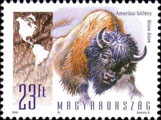 The bison limbs are low, the hind limbs is short and bent and therefore the back gently slopes down to the tail.
The animal puts both pairs of legs close in at rest, the forelegs are picked back-wards and hind legs are forward.
Wisent limbs are straight, not matched. The hind legs are long and the back to the tail has no gentle descent.
The bison limbs are low, the hind limbs is short and bent and therefore the back gently slopes down to the tail.
The animal puts both pairs of legs close in at rest, the forelegs are picked back-wards and hind legs are forward.
Wisent limbs are straight, not matched. The hind legs are long and the back to the tail has no gentle descent.
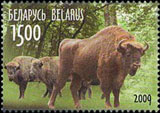 The head, beard, throat mane and chaps on the forelegs of a bison are black.
The color of the wisent is brownish-brown monotint slightly different in various parts of body both at bulls and at cows.
The head, beard, throat mane and chaps on the forelegs of a bison are black.
The color of the wisent is brownish-brown monotint slightly different in various parts of body both at bulls and at cows.
The body of the bison is hairier especially on a forward part of a body.
The forehead mane more than twice exceeds a mane of the wisent on length.
The tail is a good distinctive feature. The wisent tail is long, the tip always reaches the hocks (in the winter fur is below it).
The plains bison tail is short.
The wood bison tail is longer than the plains bison tail, but shorter than the wisent tail. |
 |
Caucasian wisent differs from the lowland wisent with dark curly hair and other features.
The horns of the Caucasian wisent are slightly curved a little back on their tips. |
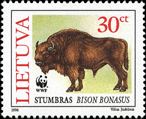 | 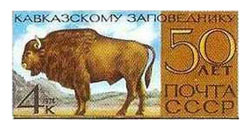 |
Lowland wisent
Bison bonasus bonasus Linnaeus, 1758 | Caucasian wisent
Bison bonasus caucasicus Satunin, 1904 |
- Relatively light in color, grayish-brown with a ochre-brown hue. Lowland calves are painted more gray.
- The hair on the whole body is almost straight or slightly curled on the sides of the pelvic area.
- Pelage of the front part of the body is rather long. The length of hair in the beard reaches 370-400 mm and on the underside of the neck 180-250 mm at an adult bull.
- Tail is long. The tip of the brush comes down below the hocks.
- Hooves is elongated. The length of the hooves of the forelegs in an adult bull varies between 90 and 105 mm. Hooves of hind legs 100-115 mm in length.
- Dimensions are very large (the largest representative of the genus Bison now living). Height in the shoulders of an adult bull is approx. 1.85 m. There are known specimens that had a height of almost 2 m in the withers. The weight of the old lowland bull can reach up to 850 kg.
|
- Darker in color, brownish-brown with a chocolate tinge. Young have a reddish tint of color.
- The wool on the whole body is strongly curly (like of domestic ram). The entire body is covered with small and steep curls. The curls on the head and neck is larger.
- Pelage of the front part of the body is significantly shorter. The length of hair in a beard does not exceed 250 mm at an adult bull and on the underside of the neck the hair has a length of about 150 mm.
- Tail is short. The tip of the brush not reaches the hocks.
- Hooves is short and tall, rounded. The length of the front hooves in an adult bull is from 70 to 85 mm. Hooves of hind legs 75-90 mm.
- Generally smaller. The height in the shoulders is approximately 1.6 m. The Caucasian wisent has thinner legs and a lighter constitution and a smaller weight than the lowland wisent.
|
 |
| American bison are further segregated into two subspecies, plains bison and wood bison well different by pelage and structural characteristics. |
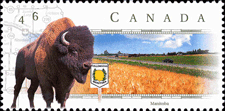 |  |
Plains bison
Bison bison bison Linnaeus, 1758 | Wood bison
Bison bison athabascae Rhoads, 1897 |
- Dense woolly bonnet of hair between horns.
- Thick beard and full throat mane, extending below rib cage.
- Well-developed chaps.
- Well-demarcated cape, lighter in colour than wood bison.
- Highest point of the hump over front
legs.
- Horns rarely extend above bonnet.
- Smaller and lighter than the wood bison (within similar age and sex classes).
|
- Forelock dark, hanging in strands over forehead.
- Thin beard and rudimentary throat mane.
- Reduced chaps.
- No clear cape demarcation, hair usually darker than plains bison.
- Highest point of the hump forward of front legs.
- Horns usually extend above forelock.
- Larger and heavier than plains bison (within similar age and sex classes).
|
 |
- Зубр. Морфология, систематика, эволюция, экология. Соколов В. Е. (отв. редактор). М.: Наука, 1979.
- Кавказский зубр. Кулагин Н. М. (отв. редактор). Москва: СНК РСФСР. Главное управление по заповедникам, зоопаркам и зоосадам, 1940.
- Флеров К. К. Обзор диагностических признаков беловежского и кавказского зубров. Известия Академ. наук СССР. Отделение матем. и естеств. наук. 1932, № 10. с. 1579-1590.
- Gates, C. C., Freese, C. H., Gogan, P. J. P. and Kotzman, M. (eds. and comps.) (2010). American Bison: Status Survey and Conservation Guidelines 2010. Gland, Switzerland: IUCN.
|




 Bison is more massive than a wisent, its head is very large with an elongated facial part and point low.
Torso is wide and barrel-shaped - eyrisome (wide-bodied) type.
Hump is not distinct. The wisent has a short high-raised head unlike the bison.
The hump is detached and the body is markedly compressed laterally.
Bison is more massive than a wisent, its head is very large with an elongated facial part and point low.
Torso is wide and barrel-shaped - eyrisome (wide-bodied) type.
Hump is not distinct. The wisent has a short high-raised head unlike the bison.
The hump is detached and the body is markedly compressed laterally.
